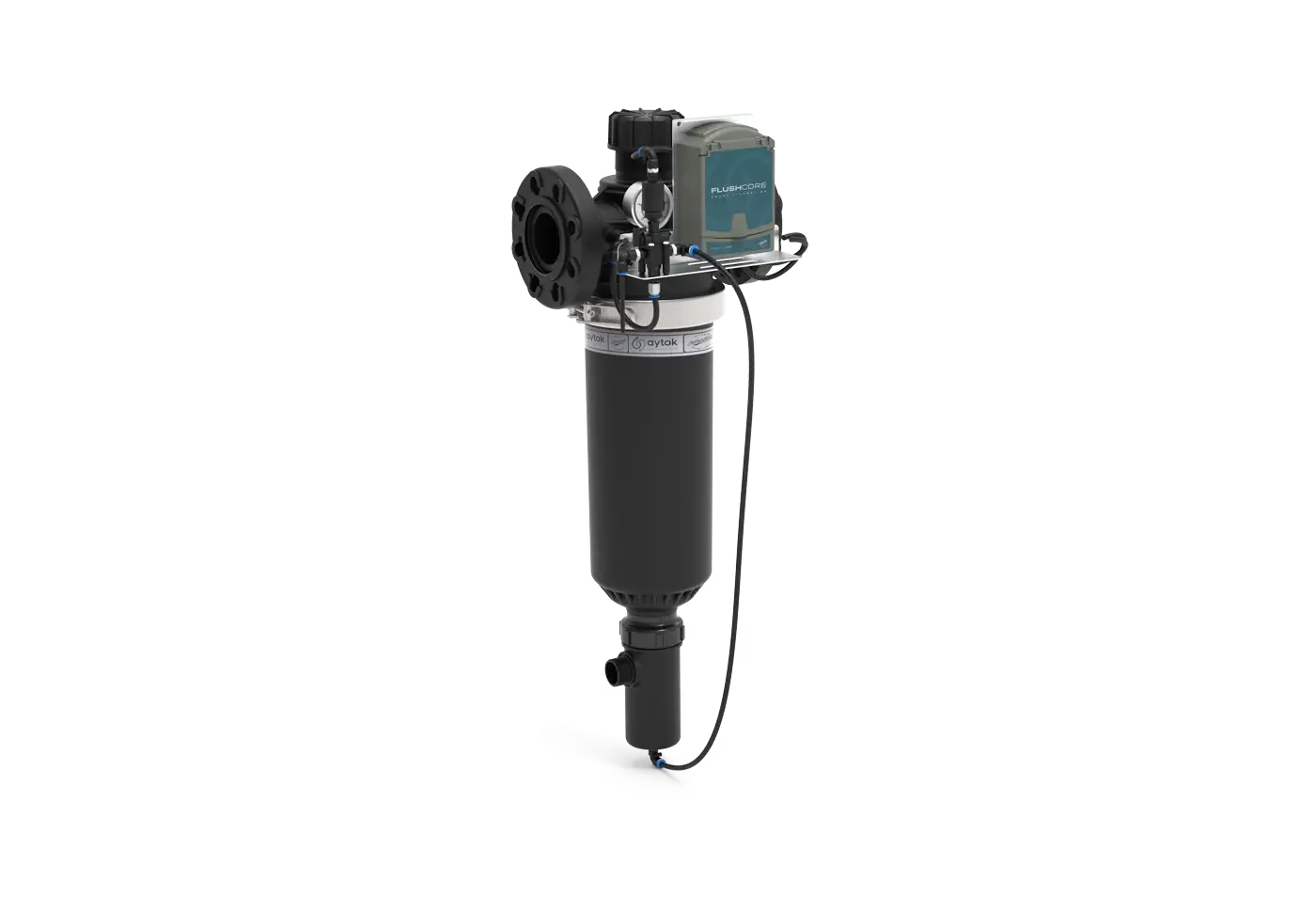| Body Material | PA6GFR30 |
| Cartridge Material | SS304L, PA6GFR30 |
| Maximum Working Pressure | 8 bar ; 116 Psi |
| Minimum Working Pressure | 2 bar ; 29 Psi |
| Maximum Working Temperature | 60 °C ; 140°F |
| Back Washing Time | Time and Pressure Difference Setup |
| Control System | Electronic (AC/DC) |
| Filtration Sensitivity | 20-2000 μ (micron) |
Ürünlerimiz
water_drop Irrigation
Uygulama Alanları
water_drop IRRIGATION
Filter Türleri
Media Center

Cleaning Process
The backwash sequence is triggered by either a preset pressure differential or a time interval. Upon activation, the control unit opens the discharge valve. Exposing this valve to atmospheric pressure creates a significant pressure drop, inducing a powerful reverse flow. This reverse flow drives a hydraulic turbine, which rotates the cleaning collector as a piston moves it linearly. The collector’s nozzles generate a high-velocity suction, vacuuming accumulated debris from the inner screen and expelling it through the drainage pipe. This combined helical motion ensures a systematic and thorough cleaning of the entire screen surface. Once complete, the discharge valve closes and the collector returns to its home position, concluding the cycle. Crucially, the main filtration process continues uninterrupted throughout this self-cleaning process.
Working Principle
Water enters the filter and passes sequentially through a coarse and then a fine screen. As contaminants accumulate on the inner surface of the fine screen, a pressure differential is created between the inlet and outlet. A backwash cycle is automatically initiated based on one of two conditions: when this pressure differential reaches a predetermined setpoint, or after a preset time interval has elapsed, whichever occurs first.
Send us a message
Fill out the form below to contact us.
P-HF Series - Plastic Self-Cleaning Screen Filters (Single Body)
GENERAL FEATURES
| Body Material | PA6GFR30 |
| Cartridge Material | SS304L, PA6GFR30 |
| Maximum Working Pressure | 8 bar ; 116 Psi |
| Minimum Working Pressure | 2 bar ; 29 Psi |
| Maximum Working Temperature | 60 °C ; 140°F |
| Back Washing Time | Time and Pressure Difference Setup |
| Control System | Electronic (AC/DC) |
| Filtration Sensitivity | 20-2000 μ (micron) |
ADVANTAGES

Cleaning Process
The backwash sequence is triggered by either a preset pressure differential or a time interval. Upon activation, the control unit opens the discharge valve. Exposing this valve to atmospheric pressure creates a significant pressure drop, inducing a powerful reverse flow. This reverse flow drives a hydraulic turbine, which rotates the cleaning collector as a piston moves it linearly. The collector’s nozzles generate a high-velocity suction, vacuuming accumulated debris from the inner screen and expelling it through the drainage pipe. This combined helical motion ensures a systematic and thorough cleaning of the entire screen surface. Once complete, the discharge valve closes and the collector returns to its home position, concluding the cycle. Crucially, the main filtration process continues uninterrupted throughout this self-cleaning process.
Working Principle
Water enters the filter and passes sequentially through a coarse and then a fine screen. As contaminants accumulate on the inner surface of the fine screen, a pressure differential is created between the inlet and outlet. A backwash cycle is automatically initiated based on one of two conditions: when this pressure differential reaches a predetermined setpoint, or after a preset time interval has elapsed, whichever occurs first.
Send us a message
Fill out the form below to contact us.
P-HF Series - Plastic Self-Cleaning Screen Filters (Single Body)
ADVANTAGES
Smart. Automated. Unstoppable.
This is the new era of plastic filtration. Our Plastic Automatic Filter fuses intelligent, handsfree automation with a rugged, corrosion-proof body to deliver a constant flow of clean water, ensuring total system protection and long-term reliability.
GENERAL FEATURES
| Body Material | PA6GFR30 |
| Cartridge Material | SS304L, PA6GFR30 |
| Maximum Working Pressure | 8 bar ; 116 Psi |
| Minimum Working Pressure | 2 bar ; 29 Psi |
| Maximum Working Temperature | 60 °C ; 140°F |
| Back Washing Time | Time and Pressure Difference Setup |
| Control System | Electronic (AC/DC) |
| Filtration Sensitivity | 20-2000 μ (micron) |
Ürün Detayı

P-HF Series - Plastic Self-Cleaning Screen Filters (Single Body)
GENERAL FEATURES
Cleaning Process
The backwash sequence is triggered by either a preset pressure differential or a time interval. Upon activation, the control unit opens the discharge valve. Exposing this valve to atmospheric pressure creates a significant pressure drop, inducing a powerful reverse flow. This reverse flow drives a hydraulic turbine, which rotates the cleaning collector as a piston moves it linearly. The collector’s nozzles generate a high-velocity suction, vacuuming accumulated debris from the inner screen and expelling it through the drainage pipe. This combined helical motion ensures a systematic and thorough cleaning of the entire screen surface. Once complete, the discharge valve closes and the collector returns to its home position, concluding the cycle. Crucially, the main filtration process continues uninterrupted throughout this self-cleaning process.
Working Principle
Water enters the filter and passes sequentially through a coarse and then a fine screen. As contaminants accumulate on the inner surface of the fine screen, a pressure differential is created between the inlet and outlet. A backwash cycle is automatically initiated based on one of two conditions: when this pressure differential reaches a predetermined setpoint, or after a preset time interval has elapsed, whichever occurs first.
ADVANTAGES
Powerful Filtration, Smarter Design.
Smart. Automated. Unstoppable.
This is the new era of plastic filtration. Our Plastic Automatic Filter fuses intelligent, handsfree automation with a rugged, corrosion-proof body to deliver a constant flow of clean water, ensuring total system protection and long-term reliability.
